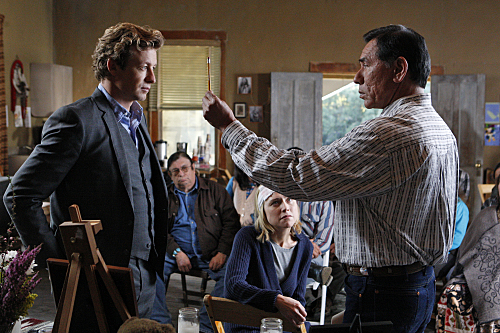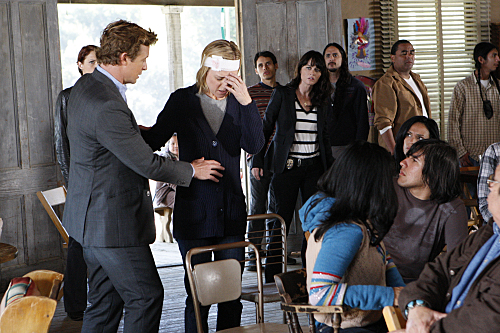Three murder victims and a fourth victim with amnesia lead the investigators to a crime on an Indian reservation.
One of the murder victims is Leonard Railton, a troubled young Shoshone man. He's been living on the Storm River Reservation with his people to straighten out his life.
The investigators talk to his parole office, Dolores Brinton, who's also from this reservation. They head to the rez where they meet Joseph Silverwing (Wes Studi), a tribal leader, and Markham Willis (Gil Birmingham), a businessman who runs a store.
Aingavite Baa is a curious case in the annals of TV Indians. As we'll see, the setup is good, the execution is bad, and the overall tone is ugly. There are no serious cultural mistakes or stereotypes, yet the result is negative.
The good
LISBON: They're aware of the investigation. We'll keep them in the loop.
BRINTON: I should go with you.
LISBON: That's not necessary.
BRINTON: As far as some of them are concerned, you're foreigners. Foreigners with badges. You won't get anything. I'll get my coat.
JANE: Excellent. Well, we've got ourselves a Native guide.
In some states I believe the state police can't go onto reservations to investigate crimes. In California, because of Public Law 280, I believe they can. Since the bodies were found off the rez, the responsibility rightly belongs to the state, not the tribe.
But then he says it's Laguna. I guess an artist in the Laguna Pueblo of New Mexico could've made a Plains headdress, but this is an odd note. Why not pick a Plains tribe instead?
Of course, I hope the producers got this from a Shoshone speaker and not just a dictionary somewhere. In many languages you can't put two words together and form a legitimate phrase. For instance, in Spanish, "red water" is agua roja, not rojo agua.
Also, I don't think aingavite baa comes up in the episode. And only one website had a translation for the phrase. So it's kind of a wasted effort.

The bad [**spoiler alert**]
Really? The waste caused those two effects but no others? No other people, animals, or plants got sick? And none of the agencies responsible for monitoring the water and the environment noticed?
It turns out the dumpers hired Willis and Railton to dump the waste. Railton got cold feet and contacted a journalist (the amnesia victim). To cover up the crime, Willis killed Railton and two witnesses and thought he killed the journalist.
The dumpers are driving trucks through the mountains at night. They're relying on an unscrupulous Indian and his young assistant. The canisters are flimsy enough to start leaking.
This is the opposite of a foolproof plan. It could go wrong in so many ways that it's not funny. If you wanted a toxic-waste plan guaranteed to fail in a few months, this is it.
He's supposedly too rattled to notice one victim is alive. Really? He loaded the bodies into a truck, drove them out of the mountains, and hauled them into a barn, but didn't check them carefully?
A criminal mastermind would've chopped off their hands (and fingerprints) or incinerated the bodies, but not Willis. He's content to gift-wrap them for the police.
The ugly
Despite the apparent effort to create a reasonable set of Indians free of mistakes and stereotypes, the show's tone is negative. The show--particularly Patrick Jane, the audience stand-in--mocks or offends Indians several times.

Perhaps worse, he questions Silverwing's honesty in front of his people. Before correcting himself, he implies Silverwing is a liar and a crook.
Jane has violated many social conventions before. But the people being violated are almost always the rich and powerful--i.e., stuffed shirts and elitists--or suspects with secrets. I don't recall his having offended a roomful of humble, honest people before.
There's a whiff of anti-Indian bias here. If the Indians were rich casino operators, or if two political factions were fighting for control, I could see a reason for Jane's attitude. But that isn't the case here. Jane appears to be prejudiced against Indians for no good reason.
LISBON: Yeah.
HIGHTOWER: Nobody got hurt?
JANE: No!
HIGHTOWER: Then to hell with him. Got justice done.
HIGHTOWER: Keep up the good work.
Alas, Hightower's voice seems to be the producers' voice. "We did an episode about Indians, but who really cares about them? Someone forced us to take out all the mistakes and stereotypes, but we showed 'em what we really think."
In reality, this incident probably would make it into the newspapers. If pro-Indian politicians--and there are many--heard about it, they'd turn it into a cause celebre. If no one in the state police was fired, someone would be forced to apologize, at least.
Conclusion
Aingavite Baa started off well. It had the ingredients for a better-than-average Indian episode. The ending was weak, but that wasn't enough to sink the show.
The show failed because of its inexplicable contempt for Indians. Mistakes and stereotypes hurt the recent episode of Castle, but I never thought that show looked down on Indians. Despite the lack of mistakes and stereotypes, this one did.
For more on the subject, see Birmingham and Studi in The Mentalist and TV Shows Featuring Indians.

1 comment:
I just saw the episode and I didn't see any stereotypes etc but I felt there was negative atmosphere in it.
I thought it was weird when that guy(forgot his name)commented on Dolores ethnicity.....
Post a Comment